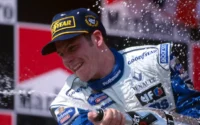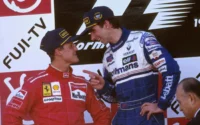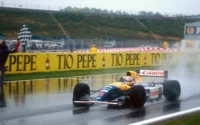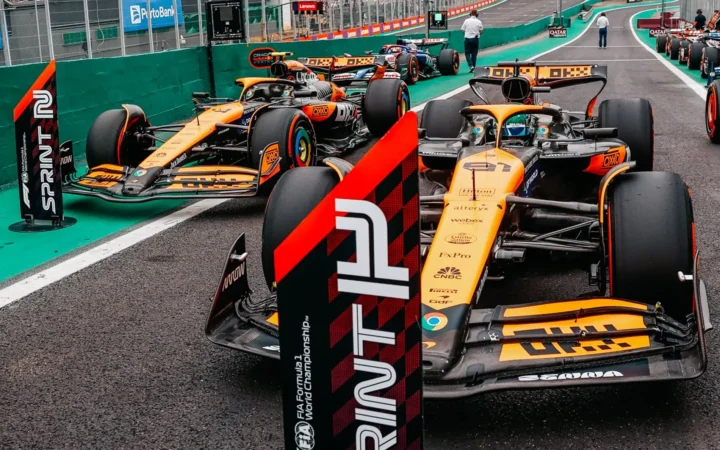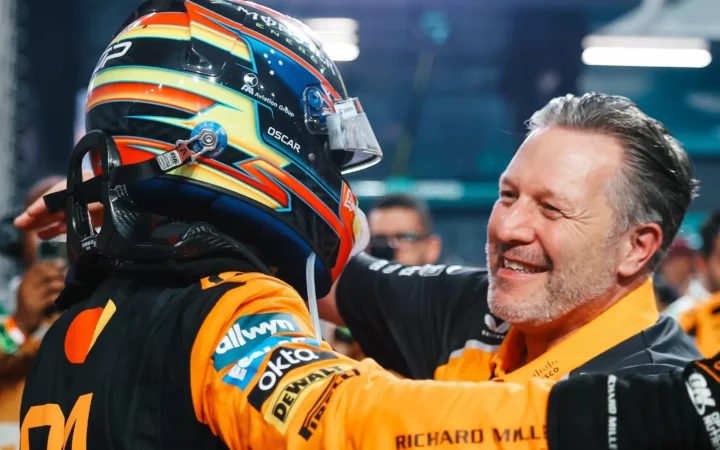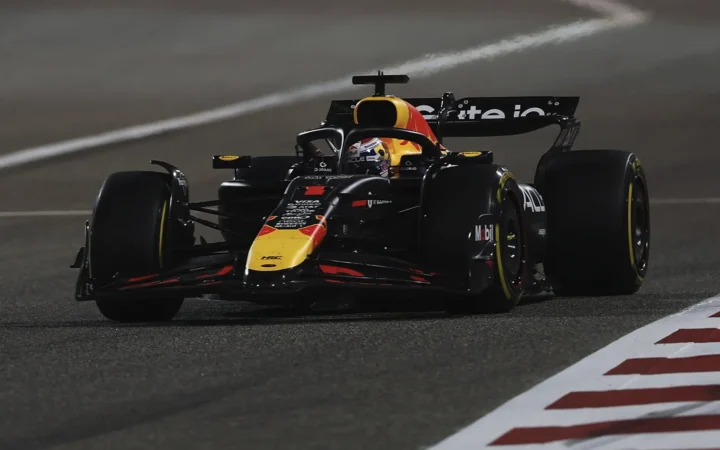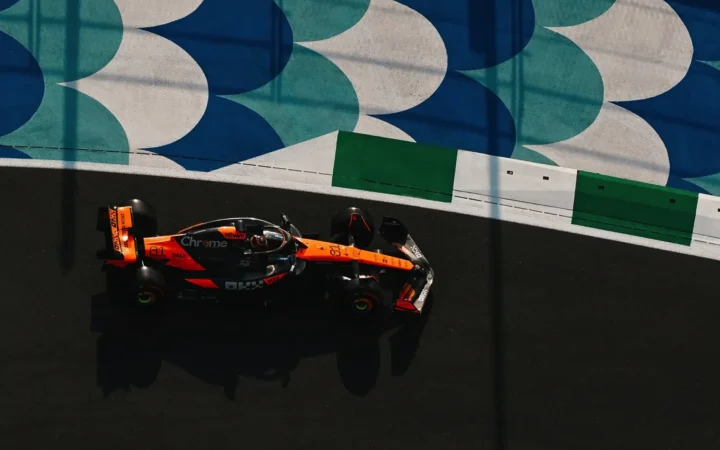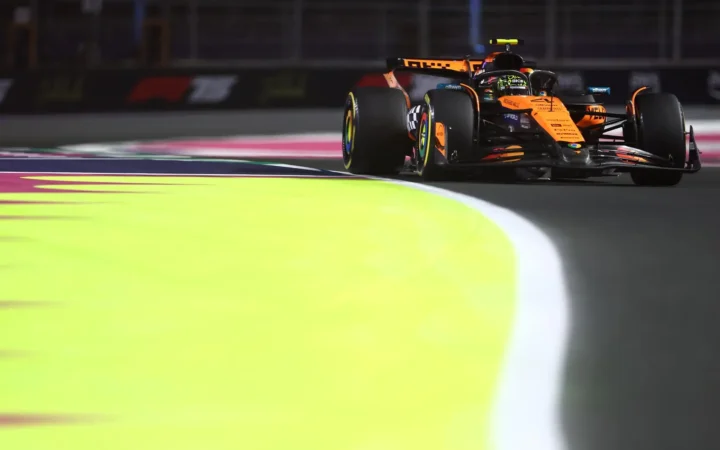What happened on this day, May 24 in Formula 1 history? Find out interesting facts and stories about Formula 1 on this day.
1903
The tragic events of the prestigious Paris-Madrid Trial in 1903 led to a significant shift in motor racing from open roads to specialised enclosed tracks. Out of 316 vehicles that started the 1014km race, more than 100,000 spectators watched the beginning. However, the roads were heavily crowded with onlookers, resulting in numerous accidents within hours. Notably, Marcel Renault, co-founder of the Renault motor company, crashed at 80mph, hitting a tree and killing himself and his mechanic. Additionally, a small boy and a man attempting to save him were also killed. In total, eight people died on the first day, prompting the French and Spanish governments to ban the race, leading to its abandonment overnight. The public backlash was so intense that the racers were not permitted to drive their cars back to Paris.
1964
Lotus driver Jim Clark secured a comfortable victory at the 1964 Dutch Grand Prix in Zandvoort, finishing ahead of the Ferrari of John Surtees. Clark took an early lead at the first corner, ahead of Graham Hill and Dan Gurney, and maintained it for 80 laps. Surtees, despite a poor start, provided the excitement in the race by moving up the field to secure second place, finishing as the only other driver on the same lap as Clark. Clark’s teammate Peter Arundell came in third.
This was the 100th Formula One World Championship race for an American driver, with Phil Hill, Richie Ginther, and Gurney driving. In those 100 races, Americans had won 15 races, had taken 76 podiums, 19 pole positions, 20 fastest laps and 1 World Championship. This race also saw the first pole position for the Brabham team.
1964 Dutch Grand Prix Race Results
| Pos | No | Driver | Car | Laps | Time/retired | Pts |
|---|---|---|---|---|---|---|
| 1 | 18 | Jim Clark | Lotus Climax | 80 | 2:07:35.400 | 9 |
| 2 | 2 | John Surtees | Ferrari | 80 | +53.600s | 6 |
| 3 | 20 | Peter Arundell | Lotus Climax | 79 | +1 lap | 4 |
| 4 | 6 | Graham Hill | BRM | 79 | +1 lap | 3 |
| 5 | 10 | Chris Amon | Lotus BRM | 79 | +1 lap | 2 |
| 6 | 34 | Bob Anderson | Brabham Climax | 78 | +2 laps | 1 |
| 7 | 24 | Bruce McLaren | Cooper Climax | 78 | +2 laps | 0 |
| 8 | 22 | Phil Hill | Cooper Climax | 76 | +4 laps | 0 |
| 9 | 26 | Jo Bonnier | Brabham Climax | 76 | +4 laps | 0 |
| 10 | 32 | Giancarlo Baghetti | BRM | 74 | +6 laps | 0 |
| 11 | 8 | Richie Ginther | BRM | 64 | +16 laps | 0 |
| 12 | 12 | Mike Hailwood | Lotus BRM | 57 | DNF | 0 |
| 13 | 36 | Jo Siffert | Brabham BRM | 55 | +25 laps | 0 |
| NC | 14 | Jack Brabham | Brabham Climax | 44 | DNF | 0 |
| NC | 4 | Lorenzo Bandini | Ferrari | 25 | DNF | 0 |
| NC | 16 | Dan Gurney | Brabham Climax | 23 | DNF | 0 |
| NC | 28 | Carel Godin de Beaufort | Porsche | 8 | DNF | 0 |
1998
McLaren driver Mika Hakkinen claimed his only Monte Carlo win at the 1998 Monaco Grand Prix with a dominant performance, securing pole position and the fastest lap. A fierce second-place battle between Alex Wurz and Michael Schumacher ended dramatically. Schumacher, eager to overtake Wurz to chase Hakkinen, tried various tactics before ultimately colliding with Wurz in a clumsy manoeuvre at the Loews hairpin, damaging his rear suspension and forcing him to pit, losing three laps. Although Wurz initially seemed unscathed, his suspension failed when he pitted for fresh tyres, causing a high-speed crash in the tunnel. Fortunately, he was unhurt, while his Benetton teammate Giancarlo Fisichella took second place, with the Ferrari of Eddie Irvine finishing third.
1998 Monaco Grand Prix Race Results
| Pos | No | Driver | Car | Laps | Time/retired | Pts |
|---|---|---|---|---|---|---|
| 1 | 8 | Mika Hakkinen | McLaren Mercedes | 78 | 1:51:23.595 | 10 |
| 2 | 5 | Giancarlo Fisichella | Benetton Playlife | 78 | +11.475s | 6 |
| 3 | 4 | Eddie Irvine | Ferrari | 78 | +41.378s | 4 |
| 4 | 17 | Mika Salo | Arrows | 78 | +60.363s | 3 |
| 5 | 1 | Jacques Villeneuve | Williams Mecachrome | 77 | +1 lap | 2 |
| 6 | 16 | Pedro Diniz | Arrows | 77 | +1 lap | 1 |
| 7 | 15 | Johnny Herbert | Sauber Petronas | 77 | +1 lap | 0 |
| 8 | 9 | Damon Hill | Jordan Mugen Honda | 76 | +2 laps | 0 |
| 9 | 22 | Shinji Nakano | Minardi Ford | 76 | +2 laps | 0 |
| 10 | 3 | Michael Schumacher | Ferrari | 76 | +2 laps | 0 |
| 11 | 21 | Toranosuke Takagi | Tyrrell Ford | 76 | +2 laps | 0 |
| 12 | 14 | Jean Alesi | Sauber Petronas | 72 | DNF | 0 |
| NC | 12 | Jarno Trulli | Prost Peugeot | 56 | DNF | 0 |
| NC | 11 | Olivier Panis | Prost Peugeot | 49 | DNF | 0 |
| NC | 10 | Ralf Schumacher | Jordan Mugen Honda | 44 | DNF | 0 |
| NC | 6 | Alexander Wurz | Benetton Playlife | 42 | DNF | 0 |
| NC | 19 | Jan Magnussen | Stewart Ford | 30 | DNF | 0 |
| NC | 7 | David Coulthard | McLaren Mercedes | 17 | DNF | 0 |
| NC | 18 | Rubens Barrichello | Stewart Ford | 11 | DNF | 0 |
| NC | 2 | Heinz-Harald Frentzen | Williams Mecachrome | 9 | DNF | 0 |
| NC | 23 | Esteban Tuero | Minardi Ford | 0 | DNF | 0 |
2000
In 2000, Giancarlo Fisichella narrowly escaped injury in a dramatic testing crash, highlighting the dangers of open-wheel racing. Fisichella’s Benetton collided with Jarno Trulli‘s Jordan during preparations for the 2000 Monaco Grand Prix in Valencia. Unable to avoid a collision in a tight section of the track, Fisichella’s car was launched into the air, flipping over Trulli’s car and landing on top of it. Despite the Benetton being completely destroyed, both drivers emerged unharmed and were able to resume testing later that day.
2001
In 2001, Jordan and Arrows caused a sensation in the Monaco paddock by arriving for Thursday practice with peculiar wings mounted high above the nose cones of their cars. These wings were intended to provide extra front downforce, but the FIA banned them immediately on safety grounds. There were also suggestions that they were banned because of their unsightly appearance.
2009
Brawn GP driver Jenson Button won the 2009 Monaco Grand Prix, a highlight in his championship-winning year, even though he missed out on winning his home race at Silverstone. Button and his Brawn teammate Rubens Barrichello dominated, finishing first and second. After the race, Button mistakenly returned to the pits instead of parking on the start-finish straight, as per Monaco tradition. Nonetheless, he enjoyed a solo run from the pits to the podium, cheered by his team and fans. Reflecting on his victory, Button said, “Winning the Monaco Grand Prix is something you dream about as a child and as a racing driver, and the reality of taking that victory just feels awesome.” Kimi Raikkonen completed the podium in third for Ferrari.
2009 Monaco Grand Prix Race Results
| Pos | No | Driver | Car | Laps | Time/retired | Pts |
|---|---|---|---|---|---|---|
| 1 | 22 | Jenson Button | Brawn Mercedes | 78 | 1:40:44.282 | 10 |
| 2 | 23 | Rubens Barrichello | Brawn Mercedes | 78 | +7.666s | 8 |
| 3 | 4 | Kimi Räikkönen | Ferrari | 78 | +13.442s | 6 |
| 4 | 3 | Felipe Massa | Ferrari | 78 | +15.110s | 5 |
| 5 | 14 | Mark Webber | RBR Renault | 78 | +15.730s | 4 |
| 6 | 16 | Nico Rosberg | Williams Toyota | 78 | +33.586s | 3 |
| 7 | 7 | Fernando Alonso | Renault | 78 | +37.839s | 2 |
| 8 | 11 | Sebastien Bourdais | STR Ferrari | 78 | +63.142s | 1 |
| 9 | 21 | Giancarlo Fisichella | Force India Mercedes | 78 | +65.040s | 0 |
| 10 | 10 | Timo Glock | Toyota | 77 | +1 lap | 0 |
| 11 | 6 | Nick Heidfeld | Sauber BMW | 77 | +1 lap | 0 |
| 12 | 1 | Lewis Hamilton | McLaren Mercedes | 77 | +1 lap | 0 |
| 13 | 9 | Jarno Trulli | Toyota | 77 | +1 lap | 0 |
| 14 | 20 | Adrian Sutil | Force India Mercedes | 77 | +1 lap | 0 |
| 15 | 17 | Kazuki Nakajima | Williams Toyota | 76 | DNF | 0 |
| NC | 2 | Heikki Kovalainen | McLaren Mercedes | 51 | DNF | 0 |
| NC | 5 | Robert Kubica | Sauber BMW | 28 | DNF | 0 |
| NC | 15 | Sebastian Vettel | RBR Renault | 15 | DNF | 0 |
| NC | 8 | Nelson Piquet | Renault | 10 | DNF | 0 |
| NC | 12 | Sebastien Buemi | STR Ferrari | 10 | DNF | 0 |
2015
At the 2015 Monaco Grand Prix, reigning World Champion Lewis Hamilton secured his first-ever pole position at the principality circuit during Saturday’s qualifying. However, the race saw his Mercedes teammate and Monaco resident, Nico Rosberg, claim his third consecutive Monaco victory, marking his second win of the season and the tenth of his career. Sebastian Vettel finished second for Ferrari, while Hamilton—who had led for most of the race—dropped to third due to a strategic error during a late-race safety car period. Mercedes later apologised for the misjudged pit stop, which cost Hamilton the victory.
The race also marked a milestone for McLaren–Honda, as they scored their first points since the partnership’s revival. With Rosberg’s win, he closed the gap in the 2015 Drivers’ Championship standings to ten points behind Hamilton.
2015 Monaco Grand Prix Race Results
| Pos | No | Driver | Car | Laps | Time/retired | Pts |
|---|---|---|---|---|---|---|
| 1 | 6 | Nico Rosberg | Mercedes | 78 | 1:49:18.420 | 25 |
| 2 | 5 | Sebastian Vettel | Ferrari | 78 | +4.486s | 18 |
| 3 | 44 | Lewis Hamilton | Mercedes | 78 | +6.053s | 15 |
| 4 | 26 | Daniil Kvyat | Red Bull Racing Renault | 78 | +11.965s | 12 |
| 5 | 3 | Daniel Ricciardo | Red Bull Racing Renault | 78 | +13.608s | 10 |
| 6 | 7 | Kimi Räikkönen | Ferrari | 78 | +14.345s | 8 |
| 7 | 11 | Sergio Perez | Force India Mercedes | 78 | +15.013s | 6 |
| 8 | 22 | Jenson Button | McLaren Honda | 78 | +16.063s | 4 |
| 9 | 12 | Felipe Nasr | Sauber Ferrari | 78 | +23.626s | 2 |
| 10 | 55 | Carlos Sainz | STR Renault | 78 | +25.056s | 1 |
| 11 | 27 | Nico Hulkenberg | Force India Mercedes | 78 | +26.232s | 0 |
| 12 | 8 | Romain Grosjean | Lotus Mercedes | 78 | +28.415s | 0 |
| 13 | 9 | Marcus Ericsson | Sauber Ferrari | 78 | +31.159s | 0 |
| 14 | 77 | Valtteri Bottas | Williams Mercedes | 78 | +45.789s | 0 |
| 15 | 19 | Felipe Massa | Williams Mercedes | 77 | +1 lap | 0 |
| 16 | 98 | Roberto Merhi | Marussia Ferrari | 76 | +2 laps | 0 |
| 17 | 28 | Will Stevens | Marussia Ferrari | 76 | +2 laps | 0 |
| NC | 33 | Max Verstappen | STR Renault | 62 | DNF | 0 |
| NC | 14 | Fernando Alonso | McLaren Honda | 41 | DNF | 0 |
| NC | 13 | Pastor Maldonado | Lotus Mercedes | 5 | DNF | 0 |
F1 Driver Birthdays 24 May
| Birthday | F1 Driver |
|---|---|
| 24 May 1953 | Lamberto Leoni |
| 24 May 1963 | Ivan Capelli |
F1 Driver Deaths 24 May
| Death | F1 Driver |
|---|---|
| 24 May 1981 | Herbert Muller (b. 1940) |
| 24 May 1990 | Dries van der Lof (b. 1919) |
| 24 May 2024 | Dave Walker (b. 1941) |
Seen in:


